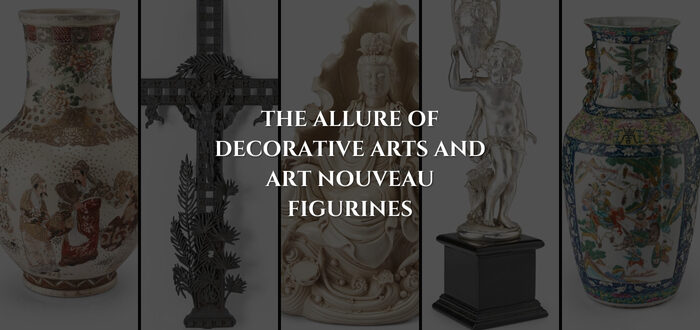The Allure of Decorative Arts and Art Nouveau Figurines
What is Decorative Art?
In the field of visual arts, “decorative art” refers to the practice of making objects that are intended for both aesthetic and practical utility. Decorative art is meant to beautify functional items so that we can enjoy them more in our daily lives. The phrase “decorative art” can be applied to more than just paintings and drawings; it can also describe architecture and sculpture.
The History of Decorative Art
The history of decorative arts can be traced back to ancient civilizations, where artisans created objects that combined utility with aesthetic appeal. From the intricate pottery of ancient Greece to the luxurious tapestries of medieval Europe, decorative arts have played a vital role in expressing cultural values and artistic trends. Decorative art was vital in ancient Egyptian, Greek, and Roman culture, serving important religious and secular functions. Craftsmen produced elaborate ceramics, linens, and jewellery for use in worship and burial.
As artists and craftspeople began to produce works that were both aesthetically pleasing and technically advanced, decorative art flourished during the Renaissance.
Artists like Benvenuto Cellini took metalwork to new heights during this time, producing works that were highly sought after by collectors due to their intricacy and ornateness.
Decorative arts have a rich and varied history, reflecting the cultural, social, and artistic movements of their times. Among the most enchanting eras in the history of decorative arts is the Art Nouveau period, which flourished from the late 19th century until the early 20th century. This era is celebrated for its intricate designs, organic forms, and the seamless blending of functionality with aesthetic beauty.
Art Nouveau Art Movement: Birth and Influences
The term Art Nouveau was first used in the 1880s in the Belgian journal L’Art Moderne to describe the work of Les Vingt, a group of twenty painters and sculptors seeking reform through art. For ten years, they held an annual exhibition of their art; each year 20 other international artists were also invited to participate in their exhibition. The name was popularized by the Maison de l’Art Nouveau (‘House of the New Art’), an art gallery opened in Paris in 1895 by the Franco-German art dealer Siegfried Bing.
Meaning of Art Nouveau
Art Nouveau, meaning “New Art” in French, emerged in the late 19th century as a reaction against the academic art and traditional design conventions that dominated the period. It drew inspiration from the natural world, incorporating flowing lines, organic forms, and intricate patterns reminiscent of plants, flowers, and animals. The movement was heavily influenced by the Symbolist movement in literature and the Arts and Crafts movement, which advocated for the revival of craftsmanship and the use of traditional materials.
Legacy and Influence
Art Nouveau’s influence transcends time, leaving a lasting legacy that resonates in the designs of today. The movement’s celebration of nature, craftsmanship, and innovation continues to inspire a new generation of artists and designers, breathing life into contemporary creations with its timeless charm.
Key Characteristics
Art Nouveau is characterized by its emphasis on curvilinear forms, often referred to as “whiplash” lines, which give the art a sense of fluidity and movement. The use of asymmetry, stylized natural elements, and a harmonious blend of various materials like glass, metal, and ceramics are other defining features. The movement also embraced modernity, with artists experimenting with new techniques and materials to create innovative designs.
Major Artists and Designers
Some of the most renowned Art Nouveau movement artists and designers include Gustav Klimt, Alphonse Mucha, Émile Gallé, and René Lalique. These artists, along with many others, contributed to the spread of Art Nouveau across Europe and beyond, influencing everything from architecture to jewellery design. Their works are celebrated for their beauty, attention to detail, and the seamless integration of art into everyday life.
Alphonse Mucha: Father of the Art nouveau Art Movement
Alphonse Mucha’s legacy in the world of Art Nouveau goes beyond just his iconic posters and advertisements. His intricate and ornate designs not only captured the essence of the movement but also served as a testament to his unparalleled skill and creativity. Mucha’s portrayal of ethereal female figures, adorned with flowing lines and delicate details, encapsulated the beauty and sensuality of the human form in a way that resonated with audiences then and continues to do so today.
Art Nouveau Figurines: A Closer Look
Art Nouveau figurines are among the most captivating expressions of the movement’s ideals. These small, often delicate sculptures embody the organic forms and intricate details that define Art Nouveau. The figurines often depict graceful women, mythological figures, or animals, all rendered with a sense of elegance and fluidity. The emphasis on natural forms is evident in the way the figures’ bodies flow and curve, often entwined with floral motifs or other natural elements.
Materials and Techniques
Art Nouveau figurines were crafted from a variety of materials, including bronze, porcelain, glass, and ivory. Bronze was particularly popular due to its durability and the fine detail it could capture.
Notable Figurine Designers
One of the most famous artists of Art Nouveau movement was the French sculptor and decorator René Lalique. Known for his innovative designs in glass, Lalique’s figurines often featured ethereal female figures, birds, and other natural forms, capturing the essence of the Art Nouveau aesthetic.
Collectability and Value
Today, Art Nouveau figurines are highly sought after by collectors and art enthusiasts. Their unique designs, historical significance, and the craftsmanship involved in their creation make them valuable additions to any collection. Prices for these figurines can vary widely, depending on factors such as the artist, material, rarity, and condition. Renowned auction houses often feature Art Nouveau figurines in their sales, highlighting their enduring appeal and market value.
Conclusion: Leaving a Lasting Legacy
Art Nouveau’s impact on contemporary design extends beyond its initial popularity, leaving a lasting imprint on the creative landscape of today. The movement’s fusion of art and nature, emphasis on handmade craftsmanship, and embrace of innovative materials continue to inspire artists and designers worldwide.
In a world where mass production often prevails, Art Nouveau’s celebration of individual artistry and dedication to quality craftsmanship serve as a reminder of the value of human creativity and skill. From the intricate ironwork of urban structures to the delicate glassware found in modern homes, the influence of Art Nouveau can be seen in the smallest details of our everyday surroundings. Contemporary artists and designers, inspired by the intricate beauty of the natural world, echo Art Nouveau’s deep appreciation for nature through the integration of organic motifs and forms in their work.
Transform Your Space with Vintage Decor
Transform your living space with figurines and other decorative arts that reflect your imagination. Discover exquisite pieces and more at our upcoming Decorative Arts Auction this December, exclusively at Giftex.






